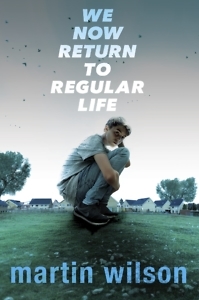Boy, Interrupted
Martin Wilson’s We Now Return to Regular Life returns an abducted boy to his family
Beth Walsh, one of the narrators of We Now Return to Regular Life by Vanderbilt graduate Martin Wilson, gets a phone call from her mother on the first day she has ever skipped school. But Beth soon realizes that truancy has nothing to do with this call: “I’m used to hearing my mother cry. For over three years it’s been a fact of life. She can be laughing one minute and then, wham, she’s leaking tears. Like she feels bad for ever having fun. I’m so used to it, it hardly ever phases me. I’m always there to hug her, rub her back, play the good daughter. But the way she sounds now is different.”

Against all odds, Beth’s younger brother, Sam, has been found and returned home, something Beth has told herself for years will never happen—a defense mechanism against foolish hope in the hopeless context of child abduction and abuse. “It’s all wrong,” she thinks as her mother tells her that Sam is already at their house as they speak. “Sam is dead. Sam is gone. He disappeared three years ago. No, more than three years ago. Vanished. Like one of those kids on the milk cartons. You never see them again. You just don’t.”
To Beth, her little brother (“active, loud, energetic—a boy”) is an unlikely victim. “Bad things didn’t happen to Sam,” according to Beth. “He’d fallen off his bike once, flipped and rolled, and all he had was a scraped elbow. When most of the kids in his third-grade class got the flu one winter, Sam was fine, not even a sniffle. He seemed invincible.” But that very boy had been abducted, and now he was home. Wilson’s honest, affecting story is not so much about what happened to Sam during his years in captivity but about the myriad psychological and emotional challenges he and his family face after he comes home.
 The novel’s other narrator is Josh Keller, the neighbor who was with Sam when he was abducted. Josh—also eleven years old at the time—has never revealed what really happened that day, successfully repressing his own survivor’s guilt, at least until Sam gets home. Josh is the only one of Sam’s old friends who doesn’t avoid him in the aftermath. They are now practically strangers, though Sam tells Josh, “We’re connected, you and me.” In that moment, Josh observes, Sam “looks triumphant and happy, smiling wide, his face flush, his chest heaving, just a normal boy having fun with his friend. Maybe his only friend in the world. We’re connected, you and me. It only dawns on me just then that this wasn’t a question. It was a fact.”
The novel’s other narrator is Josh Keller, the neighbor who was with Sam when he was abducted. Josh—also eleven years old at the time—has never revealed what really happened that day, successfully repressing his own survivor’s guilt, at least until Sam gets home. Josh is the only one of Sam’s old friends who doesn’t avoid him in the aftermath. They are now practically strangers, though Sam tells Josh, “We’re connected, you and me.” In that moment, Josh observes, Sam “looks triumphant and happy, smiling wide, his face flush, his chest heaving, just a normal boy having fun with his friend. Maybe his only friend in the world. We’re connected, you and me. It only dawns on me just then that this wasn’t a question. It was a fact.”
We Now Return to Regular Life is an important story told with candor and tenderness. Sam’s family and friends struggle not only with how to help him reacclimate to life “after” but with their own complicated emotions, an aspect of domestic trauma that seldom gets the same attention as the victim’s recovery. Though it excavates some very rough terrain, this novel is far from a downer. Teens and their parents will appreciate the honest and sensitive take on the issues presented, as well as the wealth of positive, strong-but-human characters. Martin Wilson has written a story that shows how healing is possible, even when the path forward seems too dark to navigate.

Kathryn Justice Leache lives Memphis, her hometown. Her life among books has included work as a librarian and stints as a bookseller at Square Books and The Booksellers at Laurelwood. She will soon be working at Novel, an independent bookstore opening in summer 2017 in Memphis.


